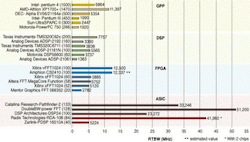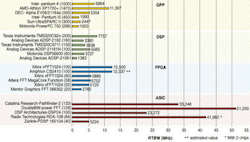FFT benchmarks position ASICs for imaging applications
Among the well-known benchmarks for image-processing systems is the fast Fourier transform (FFT). As a variation of the discrete Fourier transform (DFT), the FFT is commonly used to move a function from amplitude as a function of time to amplitude as a function of frequency. This move is essential in military applications, such as sonar, and in medical applications, such as tomography, where multiple images must be reconstructed from essentially one-dimensional data.
Now, a number of military and medical imaging systems use off-the-shelf VME boards populated with multiple DSPs and RISC processors to perform this function. While such processors can be used to partition the image-processing task, a more-effective way of computing the FFT could incorporate dedicated application-specific integrated circuits (ASICs) or field-programmable gate array-based products.
Under the guidance of Professor Dario Petri of the department of information and electronic engineering at the University of Perugia (Perugia, Italy; drake.diei.unipg.it/dspweb), data collected by Fabrizio Stefani have demonstrated the power of such implementations. Using the standard 1024-point complex FFT, Stefani has benchmarked a number of general-purpose processors, digital-signal processors (DSPs), field-programmable gate array, and application-specific integrated circuits.
The fastest times for a 1024-point, complex-FFT ASIC design came from Catalina Research (Colorado Springs, CO; www.catalinaresearch.com), doubleBW (Delft, The Netherlands; www.doublebw.com), DSP Architectures (Vancouver, WA; www.dsparchitectures.com), and Radix Technologies (Mountain View, CA; www.radixtek.com). Zarlink (Ottawa, ON, Canada; www.zarlink.com) offers the PDSP 16510A, a part originally engineered by Plessey Semiconductor in England more than six years ago.
Of all these ASICs, the doubleBW PowerFFT's 10.2-µs, 1024-point complex FFT makes it the fastest-performing FFT processor currently available. For developers wanting to evaluate the device, doubleBW offers a PCI-based development kit running under Windows XP/NT/2000/98. The real-time bandwidth (RTBW), calculated as
RTBW = N/2tFFT (Hz)
does not, however, provide the user with a complete picture of the architecture of these devices. Whereas both the Pathfinder 2 and the PowerFFT perform 32-bit floating-point operations, the DSP24 and the Race FFT (RDA 108) from Radix Technologies are 24-bit fixed-point devices; the Zarlink device performs 16-bit-block floating point.
Interestingly, normalizing the clock speed for each of these five devices provides a better measure of the efficiency of each part's architecture when performing the 1024-point complex FFT. When each part's clock speed is normalized at 100 MHz, Radix Technologies' RaceFFT, a two-chip 24-bit-block floating-point solution, benchmarks faster than the PowerFFT device.
Still, the fastest floating-point FFT device remains the doubleBW PowerFFT device, and it is finding use in medical and satellite image processing. To obtain real-time ultrasound images, for example, a FFT of long traces (up to 128K) is needed. At NRC-Soreq (Yavne, Israel), a prototype ultrasound system is being developed with the PowerFFT device that allows real-time, 3-D tissue mapping.
According to doubleBW, this will be first tested for brain imaging by Professor Feinsod at the neurosurgical department at Rambam Hospital (Haifa, Israel; www.rambam.org.il). The doubleBW PowerFFT also has been selected by the European Space Agency (Paris, France; www.esa.int) for on-board satellite remote sensing, image-processing, and spectrum-analysis applications. Currently, a radiation-hardened space-qualified version of the PowerFFT processor is in joint development with Astrium (Munich, Germany; www.astrium-space.com), a European satellite contractor.
null

